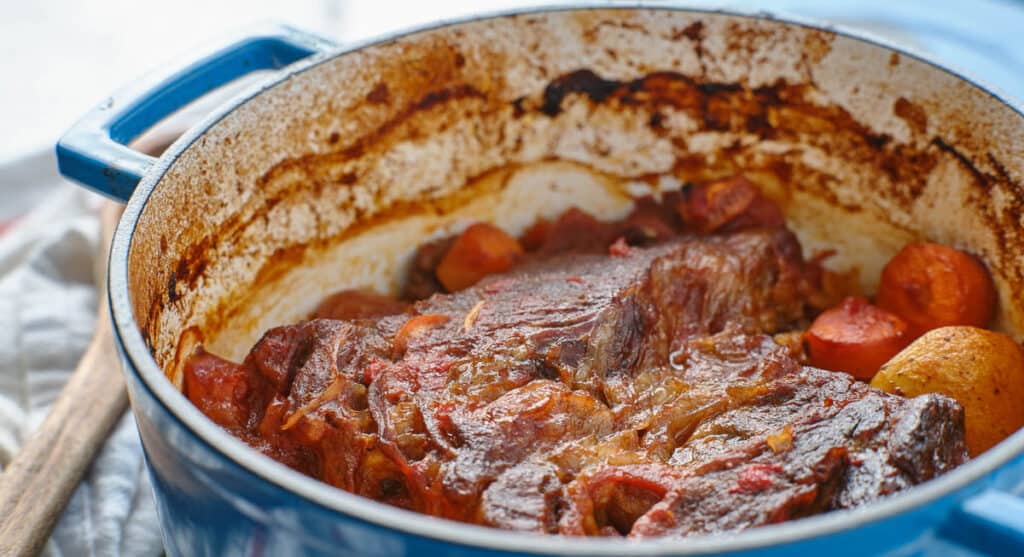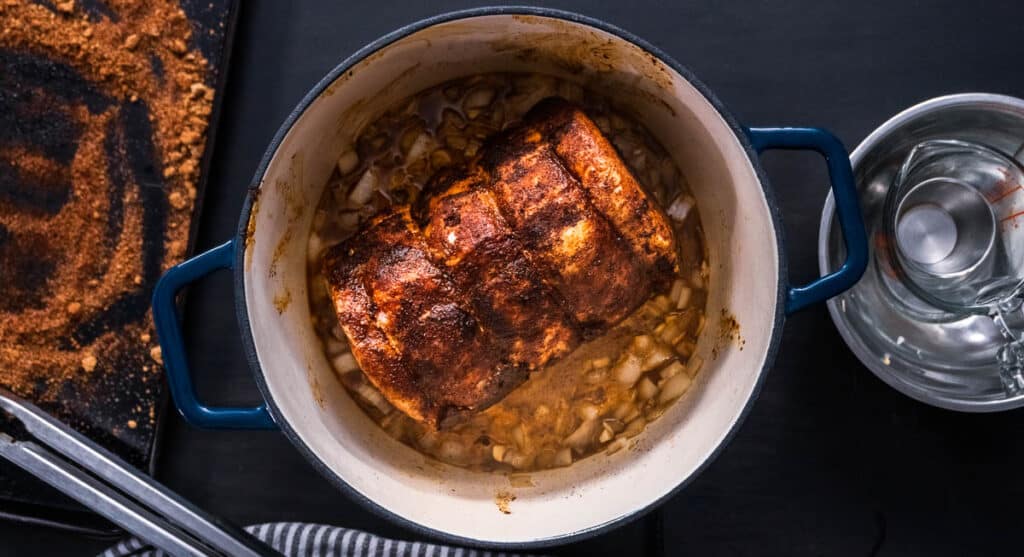Braising tenderizes tough meats and veggies using high-heat searing followed by low-temperature cooking in a covered pot with liquid. This easy-to-learn technique results in deep, rich flavors and tender meats.

Dating back centuries, braising likely began as a method to tenderize tough meats over open flames. It’s still widely used today for its ability to turn inexpensive ingredients into delicious meals.
The braising process
Braising involves two key steps: quickly searing at a high temperature and slowly cooking in liquid at a lower temperature. Using dry and wet heat is the defining characteristic of this cooking method.
Searing the main ingredient
First, heat oil in a heavy pot until hot but not smoking. Then, sear the main ingredient, whether meat or veggies, until it’s well-browned on all sides. This activates the Maillard process, a chemical reaction where proteins and sugars react to high heat and form complex flavors.
Adding liquids and aromatics
Once the main ingredient is seared, it is time to introduce liquids and aromatics, which will form the basis of the sauce. Braising liquids typically include broth, water, wine or beer.
The aromatics may include onions, garlic, carrots, celery and various fresh herbs. Bring the liquid to a simmer and cover the pot with a tight-fitting lid.
At this point, the braising process is all about slow and low. Place the covered pot in the oven or keep it at a simmer on the stovetop. It is typically cooked for at least 3 hours to allow tough cuts of meat to tenderize and develop complex flavors.

Finishing the dish
Once braising is complete, the main ingredient will be tender, and the flavors will meld. You can thicken the sauce to make a gravy if desired. Other finishing touches include a sprinkle of fresh herbs or a squeeze of lemon for brightness.
“When we get our steer processed, one of the cuts our butcher gives us is braising steak. While it’s considered a lower-quality meat, we enjoy it just as much as a filet or ribeye steak. During the cold months, we braise it on our wood stove for 3 to 4 hours in a bone broth with herbs and veggies.”
— Dan Morris, Fire and Saw
Braising vs. stewing
Both braising and stewing involve a slower cooking time, which allows flavors to blend and ingredients to tenderize. The key differences lie in the amount of liquid, the size of the main ingredient and the final dish’s texture.
Braising is well-suited for larger, tougher cuts of meat, which you cook with a small amount of liquid. On the other hand, stewing involves completely submerging smaller, uniform pieces of meat in a larger amount of liquid.
The liquid level is higher in stewing, and all ingredients are meant to break down more to create a thicker sauce or gravy. Stewing is suitable for smaller cuts of meat and mixed ingredients.
Filled with appetizers, salads, sides, mains and desserts, Food Drink Life's cookbook will become your favorite!
- Easy and delicious recipes from a variety of top chefs and recipe developers.
- Bright, colorful pictures on every page.
- Printer-friendly recipes that you can download instantly to your device.
- Printable shopping list and a kitchen conversion sheet.
Braising vs. slow cooking
Both braising and slow cooking produce tender dishes and are great at breaking down tough meat fibers. They mainly differ in the amount of time they take, the amount of liquid used and the final texture of the dish.
Slow cooking uses a lower temperature than braising, which usually means a longer cooking time. It also uses more liquid to prevent the meat from drying out during the long cooking times. It is particularly suited for meals where you can place ingredients into the device, cover it and allow it to cook unattended for hours.
Additionally, most slow cooker recipes do not have an initial searing step. Because of this, slow-cooked dishes have a less structured and more mushy texture. Each method is valuable, and the best one for each recipe depends on the time available and your desired flavor profile.

Equipment needed
The core of braising equipment is a heavy pot or pan with a tight-fitting lid. Materials that distribute heat evenly are crucial for consistent cooking. Due to their heat retention properties, cast iron and enameled cast iron are popular.
- Cast iron Dutch oven: This is an all-around excellent choice for braising. Its thick walls and heavy lid seal in moisture for even cooking.
- Enameled cast iron: It has benefits similar to regular cast iron but with a non-reactive coating ideal for cooking acidic foods.
- Braising pan: Also known as a braiser, it’s typically shallower than a Dutch oven and has a broader base, which helps brown larger cuts of meat.
Classic braising recipes
Braising is valued across diverse cultures for its ability to transform simple ingredients into flavorful dishes. Here are examples of classic braising recipes from around the globe.
- Pot roast: A timeless comfort food, pot roast is made by braising a chuck roast with root vegetables in beef stock and herbs until fall-apart tender.
- Coq au vin: This French classic involves braising chicken in red wine with mushrooms, bacon and onions, resulting in a rich and flavorful stew.
- Korean galbi jjim: This classic dish is sweet and savory, consisting of braised short ribs with a combination of soy sauce, brown sugar and Asian pear.
- Moroccan tagine: This North African specialty typically includes lamb braised with dried fruits, spices and nuts, creating an aromatic and hearty meal.
Benefits of braising
Braising unlocks and intensifies flavors from main ingredients and aromatic vegetables, melding them with herbs and spices for unparalleled depth. Tough cuts like short ribs, lamb shanks or pork shoulder thrive in this method, with low, slow heat for fork-tender texture.
Meanwhile, dense vegetables such as carrots and potatoes become tender without losing shape, thanks to the gentle simmering process. Braising is a versatile cooking technique; learning how and when to use it will help you turn inexpensive ingredients into delicious meals.
Anne Jolly is the creator of the food blog Upstate Ramblings. She loves to cook with gadgets like an air fryer, sous vide or pressure cooker. This article originally appeared on Food Drink Life.
